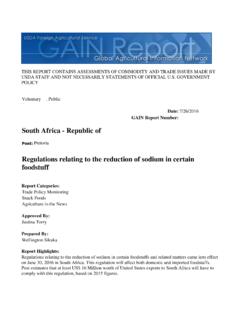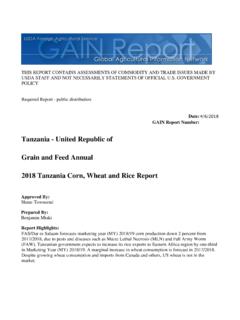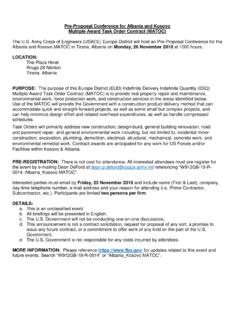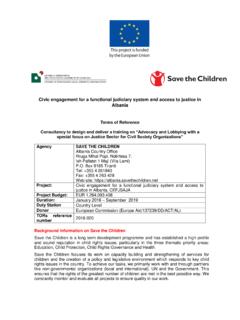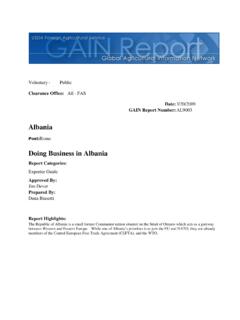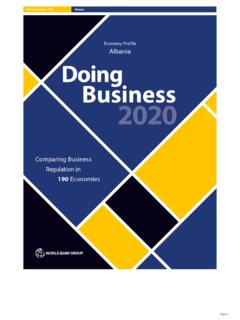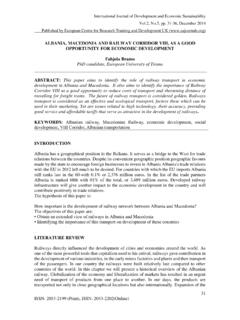Transcription of Albania Doing Business in Albania Exporter Guide 2015
1 THIS REPORT CONTAINS ASSESSMENTS OF COMMODITY AND TRADE ISSUES MADE BY USDA STAFF AND NOT NECESSARILY STATEMENTS OF OFFICIAL GOVERNMENT POLICY - Date: GAIN Report Number: Post: Report Categories: Approved By: Prepared By: Report Highlights: The Republic of Albania is a small former Communist nation situated on the Strait of Otranto which acts as a gateway between Western and Eastern Europe. While one of Albania s priorities is to join the EU they are already members of NATO, the Central European Free Trade Agreement (CEFTA), and the WTO. Albania 's economy continues to grow, as they work towards improving their economy, infrastructure, corruption problems, and high unemployment rate. In 2014, total AG exports to Albania were$ million. Dana Biasetti Christine Sloop Agricultural Situation Exporter Guide Doing Business in Albania Exporter Guide 2015 Rome Albania IT15 4/13/2015 Public Voluntary General Information: Map of Albania The Republic of Albania Overview Albania declared its independence from the Ottoman Empire in 1912, but was conquered by Italy in 1939, and occupied by Germany in 1943.
2 Communist partisans took over the country in 1944. Albania allied itself first with the USSR (until 1960), and then with China (to 1978). In the early 1990s, Albania ended 46 years of xenophobic communist rule and established a multiparty democracy. The transition has proven challenging as successive governments have tried to deal with high unemployment, widespread corruption, dilapidated infrastructure, powerful organized crime networks, and combative political opponents. Albania joined NATO in April 2009 and is waiting for membership in the European Union. They are already a member of the Central European Free Trade Agreement (CEFTA), and the WTO. One of Albania s top priorities is to join the EU and in Doing so, signed in 2006 the Stabilization and Association Agreement with the European Union. Albania s European Union (EU) membership aspirations received a boost in June 2014, when the European Commission granted Tirana EU candidate status in acknowledgment of its significant reform efforts since 2009; specifically those aimed at capacity building, improving democratic institutions and transitioning to a market economy.
3 This news was a milestone for a country that only 20 years ago emerged from communist rule as one of the poorest, most isolated and most repressive in Europe. Albania is one of only a handful of European countries that avoided a recession whilst receiving continuous foreign investment during what has proved to be the steepest downturn in the global economy since World War II. Albania 's economy continues to grow, as they work towards improving their economy, infrastructure, corruption problems, and high unemployment rate. Total estimated population is 3 million and the official language is Albanian (however many also speak Italian). Religions include Muslim, Albanian Orthodox, and Roman Catholic. The average age is 32. Albania is located on the Strait of Otranto (separating the Adriatic and Ionian seas) and acts as a gateway between Western and Eastern Europe. Albania s President of the Republic Bujar NISHANI was elected July 24, 2012, while Prime Minister Edi RAMA was elected September 10, 2013.
4 - Albania Relations The United States established diplomatic relations with Albania in 1922, but in 1939 relations ceased due to Albania 's occupation by Italy (1939-43) and Germany (1943-44) during World War II. After the fall of communism in 1991, the Albanian Government sought closer ties with the West in order to improve economic conditions and introduce basic democratic reforms. Diplomatic relations between the United States and Albania were re-established in 1991. The United States has been a strong partner and friend to Albania as it has made progress to consolidate democracy, and help the economy. The United States supports Albania 's European Union membership goal, as it did Albania 's pursuit of North Atlantic Treaty Organization (NATO) membership. and International Economic Relations In 2014, total AG exports to Albania were$ million. Major agricultural imports from the include pork, poultry, and sugar, while the main exports to the United States are spices.
5 Albania is eligible to export certain products duty-free to the United States under the Generalized System of Preferences program, and they have signed a bilateral investment treaty with the Bilateral Ag Trade 2014 (Food, Fish and Forestry) Total AG Exports to Albania : $ million Total Imports from Albania : $ million Leading Products: Poultry: $ million Spices: $ million Sugar: $ million Herbs & Drugs: $ million Pork: $1 million Horticultural Products: $420,000 Tree Nuts: $700,000 Tea: $313,000 Albania has a free trade agreement (FTA) with Turkey and is a signatory to the Central European Free Trade Agreement (CEFTA), which includes the eight countries of Albania , Macedonia, Montenegro, Kosovo, Moldova, Croatia, Serbia, and Bosnia and Herzegovina.
6 Albania also enjoys important trade benefits with EU members since it signed and ratified the Stabilization and Association Agreement (SAA). In June 2009, Albania also signed an FTA with the European Free Trade Association (EFTA). EFTA member states include Iceland, Liechtenstein, Norway, and Switzerland. The agreement with Liechtenstein and Switzerland entered into force in November 2010 and the agreement entered into force with Iceland and Norway in 2011. Albania has been a member of the WTO since September 2000 and is an observer of the Agreement of Government Procurement (GPA) accession. Albania applies a liberal trade regime following guidelines set by the EU which are in line with international trade rules. As a result of the on-going process of harmonizing its customs rules with the EU system under the SAA, imports and exports of agricultural and food products are not generally subject to special authorization requirements. The tariff system for agricultural commodities has been simplified, and is now composed of five tariff levels of most favored nations and no tariff quotas as well as differentiated seasonal tariffs, which are applied to fruits and vegetables.
7 Excise duties are applied on a group of agricultural and food products. Economic Overview Albania , coming from a closed, centrally-planned state is making the difficult transition to a more modern open-market economy. Albania , like most countries, has been affected by the global economic crisis. The agricultural sector, which accounts for almost half of the nations employment, is limited primarily to small family operations and subsistence farming due to the lack of modern equipment, unclear property rights, and the prevalence of small, inefficient plots of land. The country will continue to face challenges from increasing public debt, having exceeded its former statutory limit of 60% of GDP in 2013. Strong trade, remittance, and banking sector ties with Greece and Italy make Albania vulnerable to spillover effects of debt crises and weak growth in the euro zone. The Government of Albania is working towards creating a more competitive investment climate by undertaking qualitative changes in procedures and legislation, as well as structural reforms needed to reshape the Business environment.
8 The focus for the future development of the Albanian economy will remain to attract Foreign Direct Investments, with a particular focus on those sectors of Albania s economy that have unexploited potential, both in terms of natural resources, and sectors that are as yet under-performing, including renewable energy, tourism, agribusiness, infrastructure and services. Albania has adopted a liberal regulatory framework which has been designed to create a favorable investment climate for foreign investors. Albania is committed to building a new model of sustainable economic development, accompanied by a new fiscal discipline, boosting domestic production and the utilization of the country s natural resources as key contributors to stimulating domestic economic growth. The main priorities of the government are: fair taxation, support for entrepreneurship (with a focus on SMEs), free competition, and full accountability towards the Business community.
9 In mid-2008 Albania graduated the International Development Association (IDA) the soft financing arm of the World Bank Group focusing specifically on poor countries to the International Bank for Reconstruction and Development (IBRD), which works in partnership with several middle income economies. In May 2014, Albania received two Development Policy Loans totaling US$220mn in the areas of public finance and banking sector modernization as well as in late-September US$150mn in IBRD financing for the Power Recovery Project. Despite financial constraints, Albania has also made tangible progress on achieving its Millennium Development Goals (MDGs), although social welfare indicators still lag significantly behind Western European nations. Prior to the global financial crisis, Albania had enjoyed average annual real GDP growth rates of 6%, accompanied by rapid reductions in poverty and unemployment. GDP (purchasing power parity): $ billion (2013 est.)
10 GDP - per capita (PPP): $8,200 (2013 est.) Agriculture s % of GDP: 21% Main agricultural products: wheat, corn, potatoes, vegetables, fruits, sugar beets, grapes; meat, dairy products, and sheep Agriculture s % of labor force: 48% Unemployment rate: (2013 est.) Exchange rate: Albanian Leke per one US dollar: Treaties & Agreements Albania signed the Bilateral Investment Treaty with United States in 1995. The treaty entered into force in 1998. For a copy of the treaty please visit the following link: Albania has signed BIT and Treaties for the Avoidance of Double Taxation with numerous countries. For a list please visit the Albanian Ministry of Foreign Affairs Albania has signed free trade agreements with the following countries: Non-EU countries in Southeast Europe, Central European FTA ( Albania , Bosnia and Herzegovina, Croatia, Macedonia, Moldova, Montenegro, Serbia, Kosovo) EFTA countries (Iceland, Liechtenstein, Norway and Switzerland) Turkey Albania also enjoys important trade benefits with EU members since it signed and ratified the Stabilization and Association Agreement (SAA) in 2009 Albania s Agriculture Agriculture remains the largest and most important subsector in Albania .
